Homesteads
His name was Javier. His business card had a picture of a taxi on it – a shiny new cab that looked nothing at all like the one he actually drove. I suppose I could have taken any cab, but I wanted him, the grumpy cab driver who’d slowly been drawn into my little pilgrimage. By the time he’d returned me to the hotel after visiting my mother’s old school, we were chatting away about her life in Cuba in the 1930s and 40s. He’d volunteered to drive me again, if I wanted to go back to the school, or anywhere else.
On my first day in Havana I spent hours walking around my mother’s old neighborhood. She’d given me the coordinates of two houses her family had lived in, both within blocks of each other. One of them, a house that looked out over the ocean on la primera avenida, had been torn down and replaced. I took several pictures of the view from the corner where the house would have been, imagining a younger version of my mother, standing there herself, watching the wild waves and the windy palm trees.
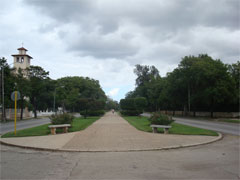
The other house they’d lived in was a few blocks inland and a few blocks over, just south of Avenida Quinta, the main avenue for traffic into the center of Havana. It must have been a posh address way back when – maybe it still is. Some houses are in various states of disrepair, but many of the homes are truly grand. Among them, embassies or residences belonging to consulates of the countries that have diplomatic ties with Cuba. This was something I saw all over Havana, the contrast of things abandoned and things restored, out of step but strangely at ease with each other, side by side.
She’d described this house as “the second one in from the southwest corner, with a patio and an iron gate.” I found what was technically the second house from the corner; it was mammoth, almost Soviet in construction. But it had what might have once been a patio (now filled with shrubbery) and an old iron gate.
Connected to it was a one-story, modern structure that seemed to be well trafficked, with a café and a small boutique. I walked in and found a friendly-looking black-vested waiter. I explained, in my faltering Spanish, that I was looking for the house my mother had lived in more than 60 years ago and how she’d told me it was the second house in from the big avenue. “Es aqui?”
He took me by the hand and walked out to the street. (This happened often, if I asked a local for directions, they’d drop what they were doing and offer sincere assistance; I encountered many acts of kindness in Cuba.) He explained that the parcel of land on which this cluster of buildings was constructed was once a garden. He escorted me down the street, pointing out three older, more traditional houses. One of those, he said, was probably the house I was looking for.
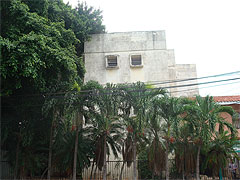
Well of course this made sense. It didn’t seem right that my mother’s old house would have been such a fortress, a cold cement building that now housed the offices of a government agency. As I walked down the block, it occurred to me that any one of the refurbished, newer-looking homes might have been raised on what had once been someone else’s garden, so that that my mother’s house could be further down the street than I’d expected.
Which is why I’d taken pictures of every house on that side of the street and sent them to my mother, via a Picasa link. The Internet was surprisingly accessible from my hotel, with a only a few exceptions: the emails I sent to a some select people, including her, mysteriously disappeared into the ether. My sister somehow could receive my messages without hindrance, so she acted as the go-between, forwarding the link. After studying the pictures, my mother wasn’t completely certain, but she thought one of them might be the house: an old dirtyish brown one with a balcony across the front.
Armed with that information, I called my taxi driver on the morning of my last day in Havana, and asked him if he’d be willing to do some driving and waiting while I went to explore what might have been my mothers childhood home.
By now the street where she’d lived was familiar to me, I’d passed by it dozens of times going to and from the center of Havana during the last week. Javier drove up in front of the brown house and stopped the car. “Buena suerte,” he said, out the window, as I was crossing the street. He was wishing me luck.
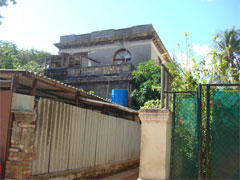
I started by taking more photographs, which attracted a bit of attention. When people came out of the house to see what I was up to; I asked their permission to continue. Nobody objected. One man with a friendly, round face introduced himself to me, his name was Miguel, and offered to take me inside the house. Three small children stood on the porch stoop. I knelt down and asked if it was okay to take their picture. They were unafraid, and very polite. I told them that I thought my mother may have grown up in this house, in their house, many years ago. “¿Se duerme en mi cama?” No, I don’t think she slept in your bed, I answered. We all giggled.
The house had surely been the home of one family many years ago, but now it was partitioned into many tiny apartments. I was moved by the poverty of one apartment; then another beside it was comfortably appointed. The common walls in the hallway were chipped and aged, the paint had come off unevenly, leaving a mosaic of colors. Miguel ushered me up the stairs and into an apartment that smelled of onions cooking. An older man, caramel skinned with gray hair, was hunched over on a single burner on the front balcony. He invited me to stay for lunch. I declined by pointing down to the street and waving at Javier, who was waiting for me in the car. He waved back.
Miguel told me the name of a family who had lived in the house, long ago, but it didn’t match my mother’s first or maiden names. I still couldn’t be certain that she’d lived here. But just in case, I snapped as many pictures as I could. I moved around to the side of the house, where a long driveway led to a screened-in porch with two dogs inside. I walked down the driveway to see what the back yard might have looked like, and a young woman came out and greeted me. Again, I was invited inside. Her mother sat on a couch and patted the chair beside her, motioning for me to sit. She’d known someone who lived in the house before, but the names she rattled off were nothing like my mother’s. I wasn’t getting a confirmation from anyone; I couldn’t be sure that this was the house.
When I explained that my mother was one of three daughters, and I named the three girls, the older woman got very animated. “¡Sí, sí, sí!” Yes, she remembered hearing about a family with three sisters. They lived two doors down the street, in the house that was now painted blue. I felt like a detective! At last, the clues were coming together. This house wasn’t my mother’s, but now I knew which one she had lived in.
I chatted with the women a while longer. They tried to tell me stories, I did my best to understand their clipped, Cuban accents. I took more photos. I said gracias no less than one hundred times. When I left, we embraced.
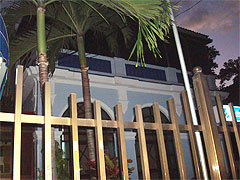
I nearly ran down the street to the blue house, which is now an office-storefront for a cellular phone company. This would have been the second house on the street. The big cement fortress had probably replaced what had once been the first house on the street, with its ample garden extending all the way to Avenida Quinta.
I had a picture of the house from an earlier visit, but it had been taken at sunset. It was hard to see. I wanted to at least get a shot of the outside with full daylight. A uniformed security guard eyed me as I raised my camera. He put his hands up to block me from taking a picture. Javier got out of the taxi and came over to help me, to explain. The guard was adamant. No photos.
But it didn’t matter, really. At least I knew which house was hers; now I had a visual bookmark for all the stories my mother has told me about her childhood.
“¿Y ahora?” Javier wanted to know where to go next. I told him the address of the other house she’d live in, the one on la primera avenida. I wanted to go back one more time.
We pulled up to the corner and parked. Instead of staying in the car, as was his custom, Javier got out and followed me across the street. We stood on the sidewalk, looking out at the water. I took out my camera. He asked if I wanted him to take a picture of me.
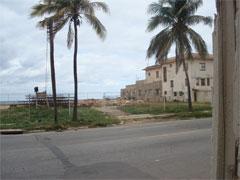
“No, gracias,“ I said.
I’d just wanted to take one more photograph, one last shot of that short stretch of beachfront, looking out at the ocean, so I could show Short-pants and Buddy-roo a view that their grandmother might have had while growing up on the beautiful, haunting, island of Cuba.
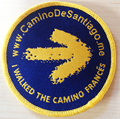
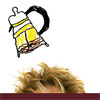
December 4th, 2009 at 4:25 am
How do you say, “what a great adventure!” in Spanish?
December 4th, 2009 at 6:13 am
What an amazing trip to take! I love your determination and the photographs, trying to piece your mother’s life. It’s like looking at a photo of your mother as a child and trying to see her not as your mother, but as a person in her own right, before ever having children.
December 4th, 2009 at 12:20 pm
This was a great closure blog from your emotional trip to Cuba. I can’t even remember if you went for pleasure or work. Kind of symbolic that you were unable to take a picture of the house the sisters lived in. It will be forever in their minds and now yours. What a treasured memory.
December 4th, 2009 at 12:56 pm
Ruth, I did go for work! There are a hundred stories I could write about that too…